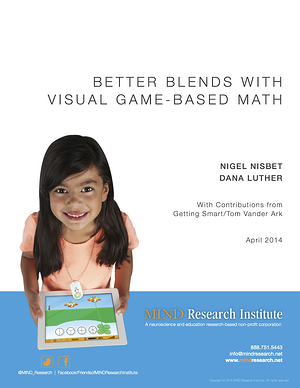
MIND’s first published white paper, Better Blends with Visual Game-Based Math, is an important addition to the education discussion about the critical role software plays in blended learning models. I am excited to be one of its co-authors, and to share with our blog readers a snapshot of what’s inside the paper.

Blended learning manifests in different forms, but there are some constants. In order to be a blended model, students need to have control over at least one of the following:
Blended learning models already are playing a crucial role in moving more students toward accessing deeper learning. MIND Research Institute’s program, ST Math®, provides an online environment in which students control the pace of their learning and are exposed to important practices that involve them in deeper learning, such as problem-solving and mistake-making. ST Math gives students a conceptual understanding of each math topic, providing a solid foundation for future math concepts or a deeper dive into the current topic.
During every ST Math session, students interpret visual manipulatives on screen to find the math in the model and solve the puzzle presented to them. When they choose their answers, the animation demonstrates why their answers were correct or incorrect, providing powerful real-time informative feedback. This feedback, especially when a mistake was made, provides students with the opportunity to assess their own thinking and to apply that assessment to the next puzzle. When teachers discuss and make connections to core curricula using ST Math in the classroom, the connections between visual math models and abstract symbols expands. So, too, does the communication around mathematics.
Blended learning will continue to expand in form and function, and will continue to push the education landscape to focus on personalized and individualized learning that will reach students in a more intentional and powerful fashion.
I am enthusiastic about the future of blended learning and how ST Math can continue and expand its impact in this way of learning.
Dana Luther is a former math teacher who was Associate Product Manager at MIND Research Institute, where she facilitates collaboration between engineering and other departments for releases and program launches.

MIND Research Institute welcomes guest blogs that highlight best practices in math education, blended learning and innovative learning strategies that inspire students at all ages.
Comment